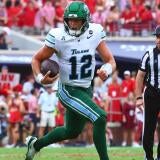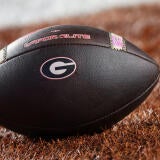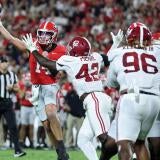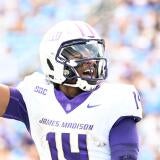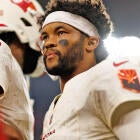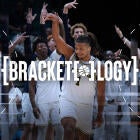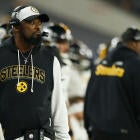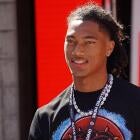About that 'Body Blow' theory and Stanford . . .
There's an old adage you often hear from football coaches, 'Don't let a team beat you two weeks in a row.' In examining what kind of carryover facing a very physical opponent can have, I looked at the toll it takes facing the Stanford Cardinal.

A few years ago I visited Mike MacIntyre after his second season at San Jose State. We spoke a lot about his first season with the Spartans. They'd gone 1-12 and faced five Top 25 teams. The worst part was a meat-grinder of a non-conference schedule, where they opened with No. 1 Alabama and then played No. 11 Wisconsin. Those two aren't just excellent teams. They're bruising, punishing teams. MacIntyre explained to me the toll facing those programs decimated his roster.
He said SJSU, which faced ranked opponents in five of its first seven games, began the season with 75 scholarship players and were down to just 40 healthy scholarship guys by the final game of 2010.
It got me to thinking more about not just who teams play, but the style the play and when they play them, and how all of that can factor into the rigors of a team's schedule. On the Solid Verbal podcast I tried to describe that dynamic as it related to a team's upcoming schedule and called it the "Body Blow" theory. Stanford seemed an ideal prism for that given the program's style of play and its physical nature in the O-line and defensive fronts.
Trying to put a gauge on the Body Blow theory is tricky. I went back and looked at every game a Stanford opponent played the game after it faced the David Yankey, Trent Murphy, Shayne Skov and company. The record of those teams is 3-6. Of course, you don't have to be much of a cynic to concede that a lot of that also depends heavily on who that opponent is.
Two of those games were against Oregon (9-1). One was against Cal (1-10). Two were against USC (8-3) -- one Lane Kiffin-coached Trojan team and one Ed Orgeron-coached Trojan team. The other four: Wake Forest (4-6); Minnesota (8-2); Arizona (6-4) and Utah (4-6).
| What happens after you play Stanford? | ||||
| Team | Game after Stanford | Rush Yds | Opp Yds | Compared to season averages |
| San Jose State | L, Minnesota 43-24 | 47 | 353 | Ran for 86 less, allowed 151 more |
| Army | L, Wake Forest 25-11 | 271 | 228 | Ran for 60 less, allowed 35 more |
| Arizona State | W, USC 62-41 | 261 | 241 | Ran for 78 more, allowed 80 more |
| Wash. State | W, Cal 44-22 | 49 | 64 | Ran for 8 less, allowed 124 less |
| Washington | L, Oregon 45-24 | 194 | 265 | Ran for 22 less, allowed 88 more |
| Utah | L, Arizona 35-24 | 172 | 300 | Ran for 8 more, allowed 157 more |
| UCLA | L, Oregon 42-14 | 219 | 325 | Ran for 17 more, allowed 157 more |
| Oregon State | L, USC 31-14 | 92 | 242 | Ran for 22 more, allowed 91 more |
| Oregon | W, Utah 44-21 | 145 | 116 | Ran for 141 less, allowed 28 less |
A better barometer would be to check how these teams ran the ball and how well they stopped the run the following week compared to their own season averages.
What I found: five teams didn't run the ball as well as normal; four ran it better. Overall, it worked out to be the opponent was held 21 rushing yards below their average. Stopping the run seemed to be a bigger issue. Seven of the nine opponents allowed more rushing yards. The one big outlier was Washington State, which held a horrible Cal team to 124 rushing yards below its average. Overall, these defenses allowed 67 rushing yards more than their average, which seemed to be the strongest point backing the Body Blow theory.
I bounced the topic off UCLA offensive coordinator Noel Mazzone, whose team promptly followed up a loss to Stanford with a 42-14 loss at Oregon, where the Bruins were completed wilted in the second half, getting outscored 28-0.
"They're definitely the most physical team we play," said Mazzone. "We got a couple of linemen banged up after playing them. I can't speak for our defense but I do think there's something to that."
The Bruins lost starting LT Simon Goines (knee) and then back-up LT Conor McDermott (separated shoulder) against the Cardinal. Linebacker Eric Kendricks, the Pac-12's leading tackler in 2012, had to be taken to Stanford Hospital at halftime of the game against the Cardinal with reports of kidney pain.
Oregon State, which got subsequently thumped by USC 31-14 and lost to the Trojans for the first time in Corvallis since 2004, also paid a hefty price for the Cardinal game, as OSU beat writer Lindsay Schnell detailed to me:
Kevin Cummings, a senior slot receiver, suffered a broken wrist in the game. Linebacker D.J. Alexander got a shoulder stinger and didn't even play in the USC game. Neither did tight end Caleb Smith who injured his back against Stanford. Fifth-year senior John Braun, one of OSU's starting DTs, had season and career-ending shoulder surgery after Stanford.
After researching this, I'm not sure how much stronger I feel about the Body Blow theory. Like Mazzone said, I think there is something to it. Then again, like most stat-related things, people can read what they want into it.
Oh, and one other note: As Allen Kenney of Blatant Homerism pointed out, teams are 2-7 against the spread the game after facing Stanford.

